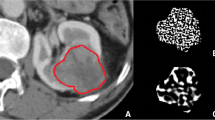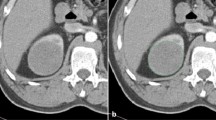Abstract
Purpose
To investigate the feasibility of using CT texture analysis (CTTA) to differentiate between low- versus high-grade urothelial carcinoma.
Methods
A total of 105 patients with high-grade urothelial carcinoma (HGUC, n = 106) and low-grade urothelial carcinoma (LGUC, n = 18) were included in this retrospective study. Both unenhanced and enhanced CT images representing the largest cross-sectional area of the tumor were chosen for CTTA performed using TexRAD software. Comparison of texture parameters, mean gray-level intensity (Mean), standard deviation, entropy, mean of positive pixels (MPP), skewness, and kurtosis were made for the objective. Receiver operating characteristic (ROC) analysis was performed and the area under the ROC curve was calculated for texture parameters that were significantly different (P < 0.05) for the purpose. Sensitivity (Se), specificity (Sp), positive predictive value, negative predictive value, and accuracy were calculated using the cut-off value of texture parameter with the highest AUC.
Results
Compared to HGUC, LGUC had significantly lower Mean (P = 0.001), Entropy (P = 0.002), and MPP (P < 0.001) on unenhanced and enhanced images and lower SD (P = 0.048) on enhanced images. There was no significant difference in skewness or kurtosis at any texture scale on unenhanced and enhanced images. A MPP <24.13 at fine texture scale on unenhanced images identified LGUC from HGUC with the highest AUC of 0.779 ± 0.065 (Se = 72.2%, Sp = 84.9%, PPV = 44.8%, NPV = 94.7%, and accuracy = 83.1%).
Conclusions
CTTA proved to be a feasible tool for differentiating LGUC from HGUC. MPP quantified from fine texture scale on unenhanced images was the optimal diagnostic parameter for estimating histologic grade of urothelial carcinoma.


Similar content being viewed by others

References
GLOBOCAN (2012) Estimated cancer incidence, mortality and prevalence worldwide in 2012. http://globocan.iarc.fr. Accessed 28 Aug 2016
Munoz JJ, Ellison LM (2000) Upper tract urothelial neoplasms: incidence and survival during the last 2 decades. J Urol 164:1523–1525
Rouprêt M, Babjuk M, Böhle A, et al. (2015) Urothelial carcinomas of the upper urinary tract. Eur Urol 68:868–879
Oosterlinck W, Lobel B, Jakse G, et al. (2015) Guidelines on bladder cancer. Eur Urol 41:105–112
Lopez-Beltran A, Sauter G, Gasser T, et al. (2004) World Health Organization classification of tumours: pathology and genetics of tumours of the urinary system and male genital organs: pathology genetics tumors urinary system male genital organs. Lyon: IARC
Fiuk JV, Schwartz BF (2016) Upper tract urothelial carcinoma: paradigm shift towards nephron sparing management. World J Nephrol 5:158
Reis LO, Taheri D, Chaux A, et al. (2016) Significance of a minor high-grade component in a low-grade noninvasive papillary urothelial carcinoma of bladder. Hum Pathol 47:20–25
Margulis V, Shariat SF, Matin SF, et al. (2009) Outcomes of radical nephroureterectomy: a series from the upper tract urothelial carcinoma collaboration. Cancer 115:1224–1233
Miyamoto H, Brimo F, Schultz L, et al. (2010) Low-grade papillary urothelial carcinoma of the urinary bladder: a clinicopathologic analysis of a post-World Health Organization/International Society of Urological Pathology classification cohort from a single academic center. Arch Pathol Lab Med 134:1160–1163
Green DA, Rink M, Xylinas E, et al. (2013) Urothelial carcinoma of the bladder and the upper tract: disparate twins. J Urol 189:1214–1221
Smith AK, Stephenson AJ, Lane BR, et al. (2011) Inadequacy of biopsy for diagnosis of upper tract urothelial carcinoma: implications for conservative management. Urology 78:82–86
Zhou G, Chen X, Zhang J, et al. (2014) Contrast-enhanced dynamic and diffusion-weighted MR imaging at 3.0T to assess aggressiveness of bladder cancer. Eur J Radiol 83:2013–2018
Wang HJ, Pui MH, Guo Y, et al. (2015) Multiparametric 3-T MRI for differentiating low-versus high-grade and category T1 versus T2 bladder urothelial carcinoma. AJR Am J Roentgenol 204:330–334
Yoshida S, Kobayashi S, Koga F, et al. (2013) Apparent diffusion coefficient as a prognostic biomarker of upper urinary tract cancer: a preliminary report. Eur Radiol 23:2206–2214
Ganeshan B, Burnand K, Young R, Chatwin C, Miles K (2011) Dynamic contrast-enhanced texture analysis of the liver: initial assessment in colorectal cancer. Invest Radiol 46:160–168
Castellano G, Bonilha L, Li LM, Cendes F (2004) Texture analysis of medical images. Clin Radiol 59:1061–1069
Davnall F, Yip CSP, Ljungqvist G, et al. (2012) Assessment of tumor heterogeneity: an emerging imaging tool for clinical practice? Insights Imaging 3:573–589
Ganeshan B, Miles KA, Young RCD, et al. (2010) Three-dimensional textural analysis of brain images reveals distributed grey-matter abnormalities in schizophrenia. Eur Radiol 20:941–948
Hodgdon T, Mcinnes MDF, Schieda N, et al. (2015) Can quantitative CT texture analysis be used to differentiate fat-poor renal angiomyolipoma from renal cell carcinoma on unenhanced cT images? Radiology 276:787–796
Yan L, Liu Z, Wang G, et al. (2015) Angiomyolipoma with minimal fat: differentiation from clear cell renal cell carcinoma and papillary renal cell carcinoma by texture analysis on CT images. Acad Radiol 22:1115–1121
Miles KA, Ganeshan B, Hayball MP (2013) CT texture analysis using the filtration-histogram method: what do the measurements mean? Cancer Imaging 13:400–406
Yip C, Landau D, Kozarski R, et al. (2014) Primary esophageal cancer: heterogeneity as potential prognostic biomarker in patients treated with definitive chemotherapy and radiation therapy. Radiology 270:141–148
Ganeshan B, Goh V, Mandeville HC, Hoskin PJ, a Miles K (2013) Non-small cell lung cancer: histopathologic correlates for texture. Radiology 266:326–336
Zhang H, Graham C, Elci O, Griswold M (2013) Advanced squamous cell carcinoma of the head and neck: CT texture and histogram analysis allow independent prediction of overall survival in patients treated. Radiology 269:801–809
Ng F, Kozarski R, Miles KA, Goh V (2013) Assessment of primary colorectal cancer heterogeneity by using whole-tumor texture analysis: contrast-enhanced. Radiology 266:1–4
Ganeshan B, Panayiotou E, Burnand K, Dizdarevic S, Miles KA (2012) Tumour heterogeneity in non-small cell lung carcinoma assessed by CT texture analysis: a potential marker of survival. Eur Radiol 22:796–802
Goh V, Nathan P, Juttla JK, Miles KA (2011) Assessment of response to tyrosine kinase inhibitors in metastatic renal cell cancer: CT texture as a predictive biomarker. Radiology 261:165–171
Miles KA, Ganeshan B, Griffiths MR, Young RCD, Chatwin CR (2009) Colorectal cancer: texture analysis of portal phase hepatic CT images as a potential marker of survival. Radiology 250:444–452
Ganeshan B, Miles KA, Young RCD, Chatwin CR (2009) Texture analysis in non-contrast enhanced CT: impact of malignancy on texture in apparently disease-free areas of the liver. Eur J Radiol 70:101–110
Ng F, Ganeshan B, Kozarski R, Miles KA, Goh V (2013) Assessment of primary colorectal cancer heterogeneity by using whole-tumor texture analysis: contrast-enhanced CT texture as a biomarker of 5-year survival. Radiology 266:177–184
Rosenkrantz AB, Haghighi M, Horn J, et al. (2013) Utility of quantitative MRI metrics for assessment of stage and grade of urothelial carcinoma of the bladder: preliminary results. AJR Am J Roentgenol 201:1254–1259
Acknowledgments
We had like to thank Dr. Balaji Ganeshan from Feedback Plc, Cambridge, England, UK, for his guidance and assistance to using the TexRAD software. This study was funded by the Health Industry Special Scientific Research Project of China (Grant Number 201402019).
Author information
Authors and Affiliations
Corresponding authors
Ethics declarations
Conflict of interest
The authors declare that they have no conflict of interest.
Ethical approval
All procedures performed in studies involving human participants were in accordance with the ethical standards of the institutional and/or national research committee and with the 1964 Helsinki declaration and its later amendments or comparable ethical standards.
Informed consent
Informed consent from all individual participants included in this retrospective study was waived by the institutional review board.
Electronic supplementary material
Below is the link to the electronic supplementary material.
261_2016_897_MOESM1_ESM.pdf
Texture parameters for discriminating LGUC from HGUC on unenhanced and enhanced CT images: (a) IQR interquartile ranges., (b) Data are median of each parameter per lesion and data in parentheses are inter-quartile ranges, unless otherwise indicated (PDF 18 kb)
Rights and permissions
About this article
Cite this article
Zhang, GMY., Sun, H., Shi, B. et al. Quantitative CT texture analysis for evaluating histologic grade of urothelial carcinoma. Abdom Radiol 42, 561–568 (2017). https://doi.org/10.1007/s00261-016-0897-2
Published:
Issue Date:
DOI: https://doi.org/10.1007/s00261-016-0897-2



